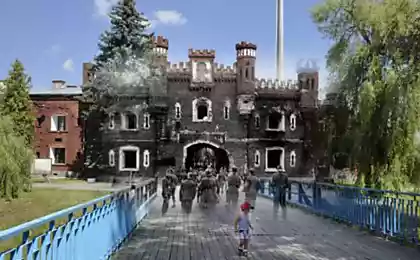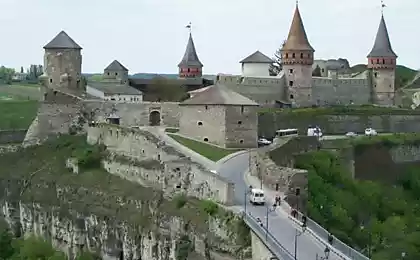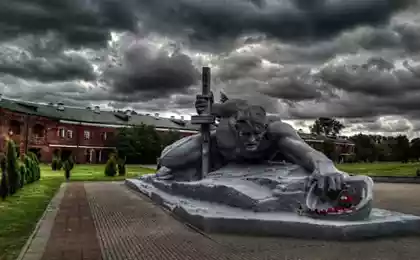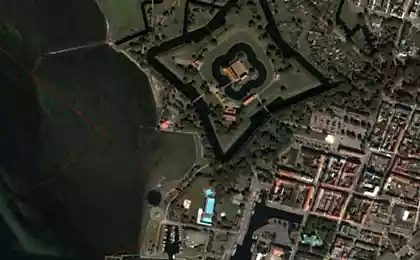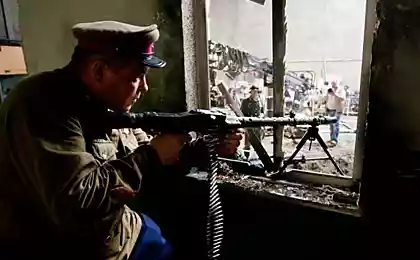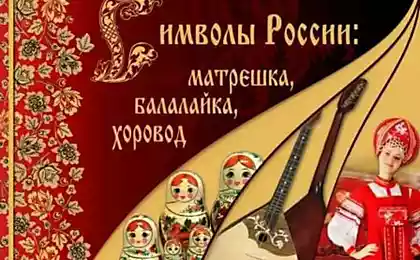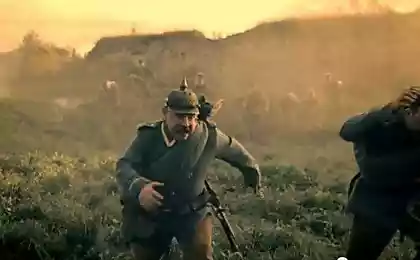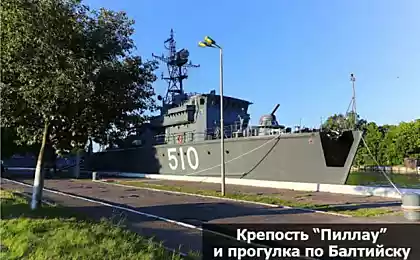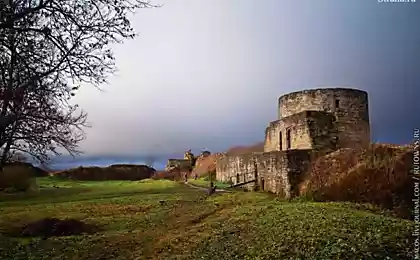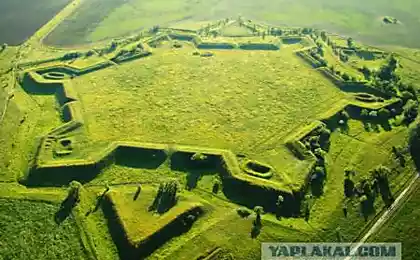2335
The Brest Fortress
Picture taken June 20, 2014 On this day, changeable weather favored shooting, allowing photographs acquired certain "solemnity".
In addition, the survey was conducted by the method of "bracketing" (bracketing) pairs and triplets in different exposures, and then they were assembled into one image to the computer to increase the dynamic range - machinery HDR.

Historical information.
Brest fortress was built in the 30th - early 40-ies of the XIX century in the Western Bug river crossings and Mukhavets in place of the old Brest.
During construction, the entire town was moved to a new territory to the east of the citadel.
The fortress was located on 4 islands formed by bayous Mukhavets and Western Bug and channel system.
In the center of the fortress is the Citadel, or the central reinforcement, which is connected by bridges with 3 artificial island fortifications. This:
Kobrin strengthening (north-east side)
Terespol strengthening (west side)
Volyn fortification (south island)
Architecture Centre Citadel - Garrison Nicholas Church, built in the 1851-76 biennium.
The total area of the fortress is about 4 square kilometers.
From August 1915 until the end of World War Brest fortress was occupied by German troops.
In 1921, under the terms of the Treaty of Riga was ceded to Poland, which was composed before 1939.
In 1939, the Brest Fortress was transferred to the Soviet Union.
June 22, 1941 the garrison received the first blows Nazi invaders and more than a month kept the defense completely surrounded. After the war, for the courage and heroism of the defenders during its defense, the citadel has received the honorary title "Hero-Fortress».
The main entrance to the memorial complex is embedded in a concrete shaft parallelepiped with carved five-pointed star in it. Block supported slope rampart. Aisle width main entrance - 18, 5 m, length of reinforced concrete blocks - 44 m, height - 10 m, width - 35 m. The construction of 700 cubic meters of concrete were spent.
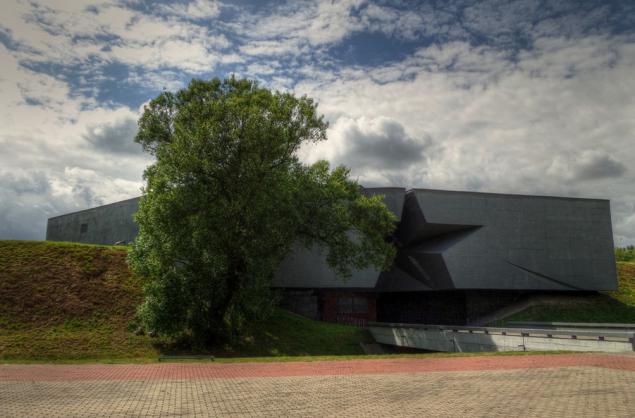
3. Concrete block rests on the earth mound and casemates, partially crashing and hanging over them. The internal design of the concrete block (40x35 m, height - 14 m) - made in prefabricated monolithic frame. External floors were made of reinforced concrete in the formwork clean, traces of which remain on the walls, giving them a peculiar form. Passage walls are lined with polished dark granite that contrasts with the speakers in the opening ruins casemates.
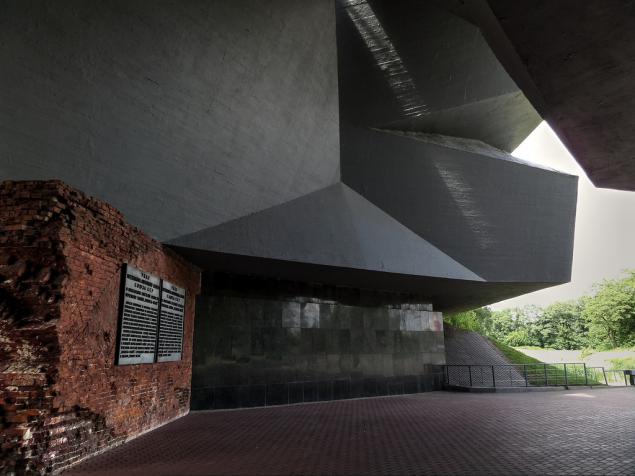
4. This creates a visual and emotional and psychological effect. Complement its radio call sign of the Central Soviet Union - the melody "Song of the Motherland" composer Dunayevsky, Yu.Levitana voice, which notifies the treacherous attack of Nazi Germany on the Soviet Union, the song composer A.Aleksandrova "holy war", the sounds of bombing and shooting. < br />
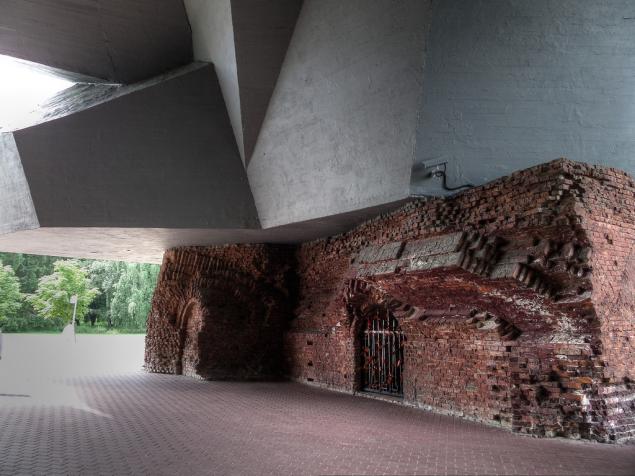
...
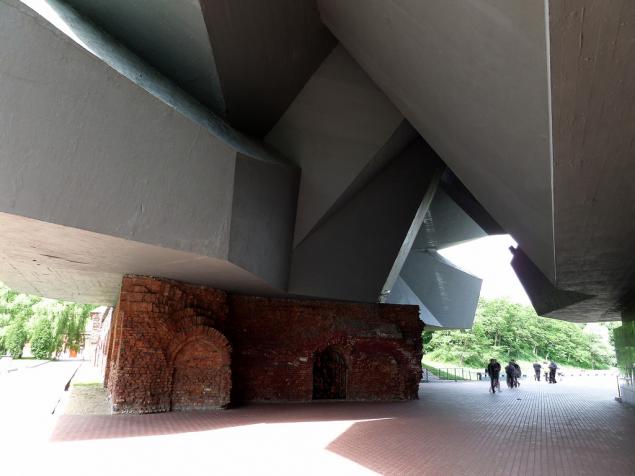
...

7. The Road to the Citadel.

8. On both sides of the entrance - casemates eastern part of the main shaft of the fortress. On the brick wall of one of them on the board of silver iron - cast in bronze text of the decree of the Presidium of the Supreme Soviet of the USSR in Russian and Belarusian languages on assignment Brest Fortress title "Hero-Fortress". The star doorway entrance reveals a view of the central part of the fortress.
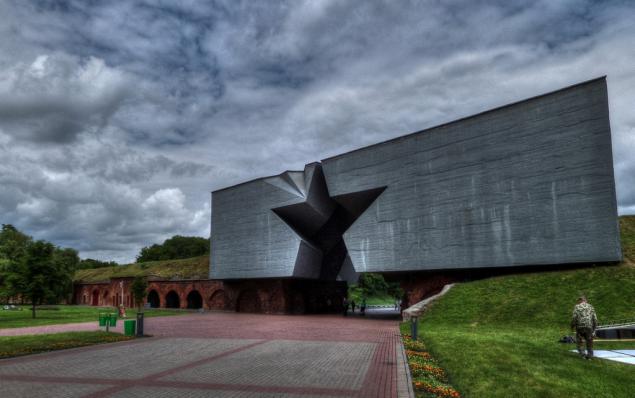
...

10, 11. The view of the Citadel.

...

12. At the Citadel, on the left bank of the bayou is Mukhavets sculpture "Thirst».
One of the dramatic pages of Brest Fortress - an acute shortage of water. Water supply has been disabled on the first day of the war, and the summer that year stood unusually hot. Smoke, burning gunpowder filled the horizon.
Blackened faces of fighters, parched with thirst lips showed incredible suffering people. The water was needed to cool the machine guns, the wounded, women and children - all participants of Defense. It seemed to the river and take it, but the approaches to water shelled, floodlit at night shore. Many soldiers and officers were killed, trying to extract the precious drops. After the war, on the banks of the rivers found punched helmets, water bottles, mugs, and the remains of the victims. The creators of the memorial, knowing about this tragedy, decided to talk about it, using the skill of the sculptor. The figure of a soldier crawling to the water with his helmet in his hand, does not leave anyone indifferent.
Today outstretched helmet - fresh flowers from visitors to the fortress.
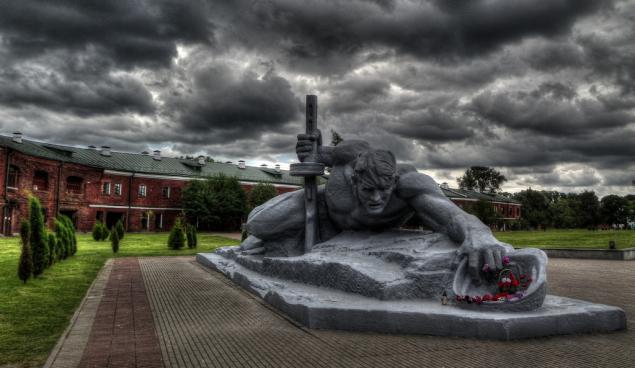
13-16. Ruins near Kholmsky gate.
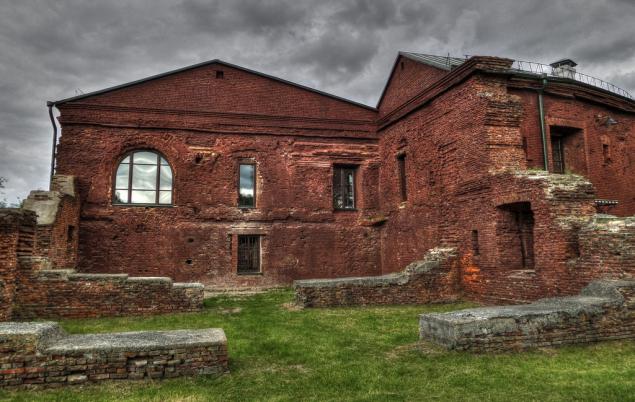
...
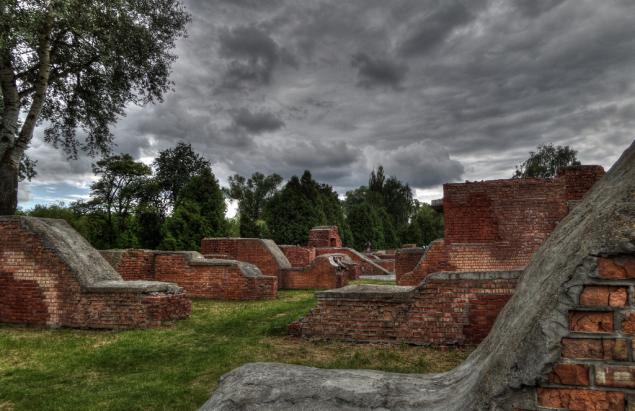
...
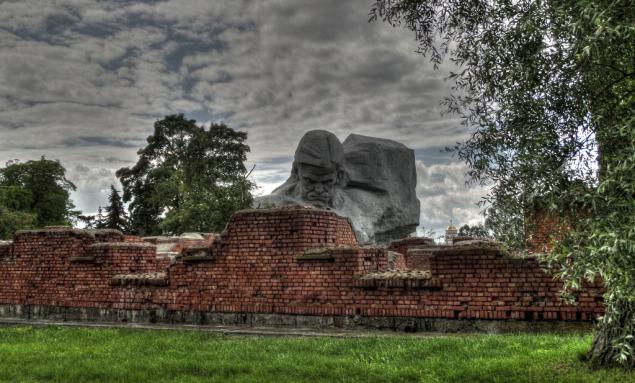
...
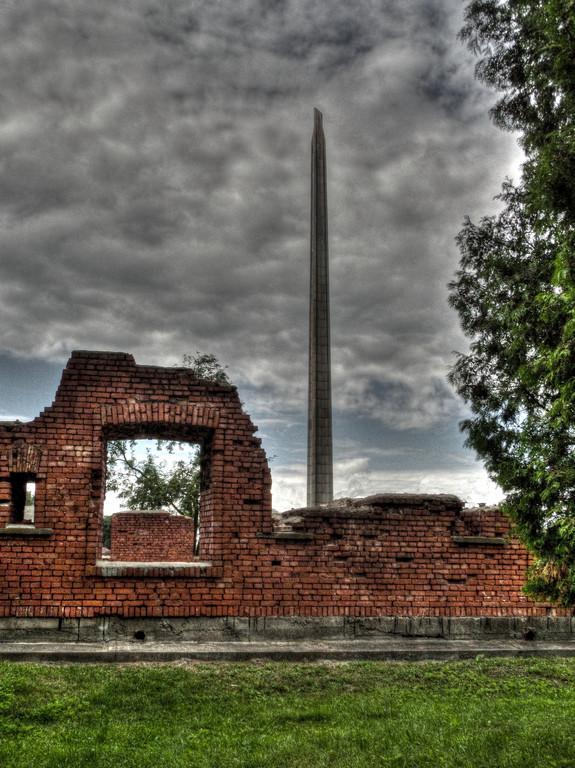
17. Kholm Gate. Previously had 4 towers with battlements. Over the entrance aperture Terespolsky was 4 tiers of windows, battlements over which later built on a 3-tiered tower with a lookout platform.
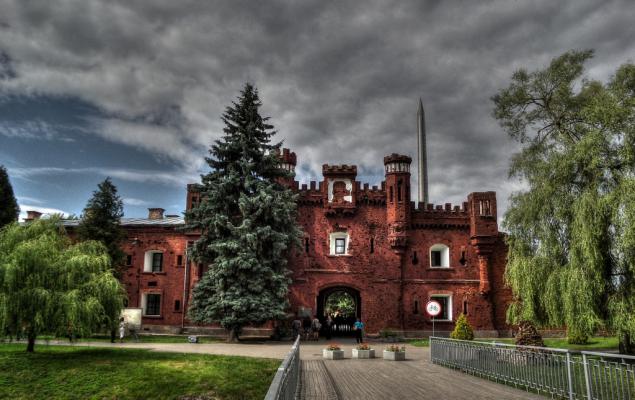
18. "Here, in June 1941, fought heroically against the Nazi invaders separate battalion of 132 soldiers of the NKVD. Eternal glory to the heroes. »
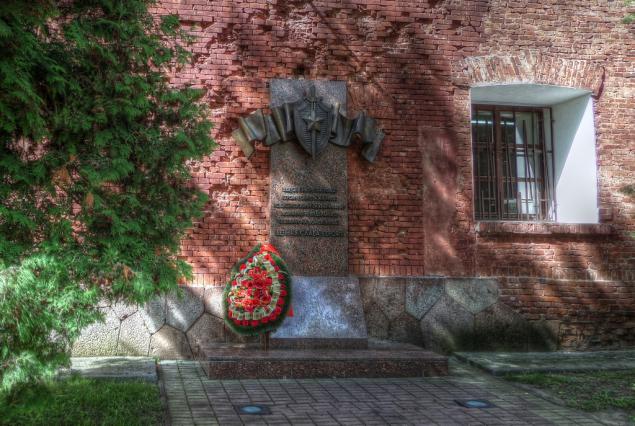
19. The river empties into Mukhavets r.Zapadny Bug. The border with Poland.

20. View Terespolsky gate.
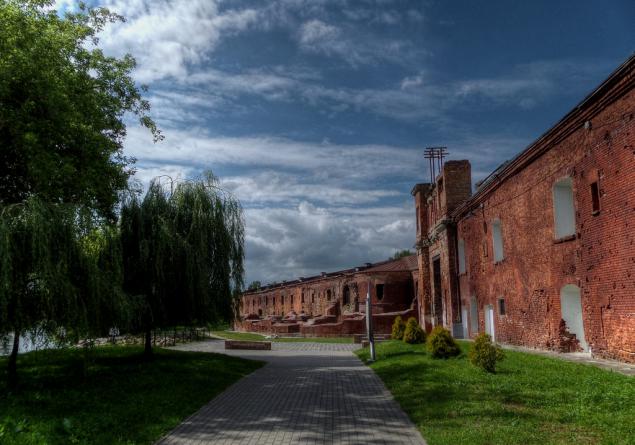
21. Terespolsky gate.
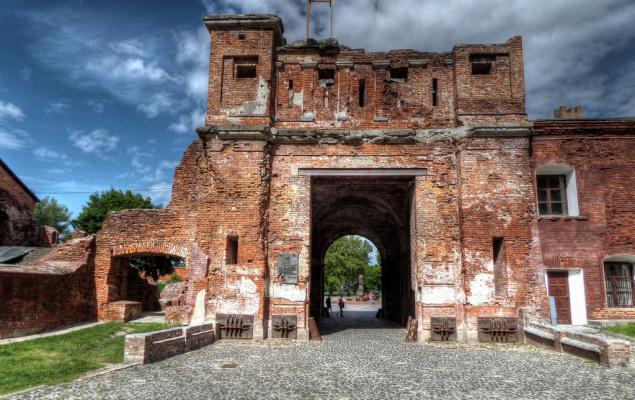
22. Location Bialystok (Brigitskih) wide. Dismantled after the war.
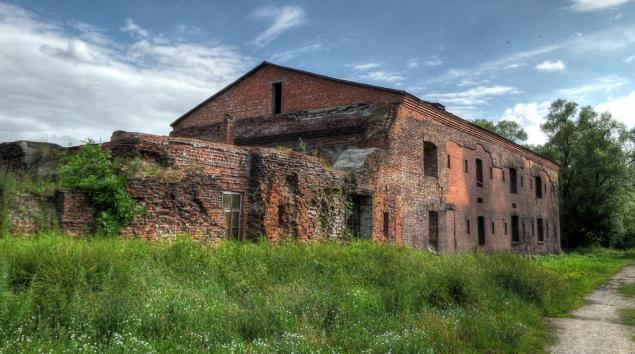
23. Could not figure out what it is - the remains of a bridge or part of a system of locks. Or complex engineering system.
Strictly speaking, this is the border zone and we need a passport with a pass.
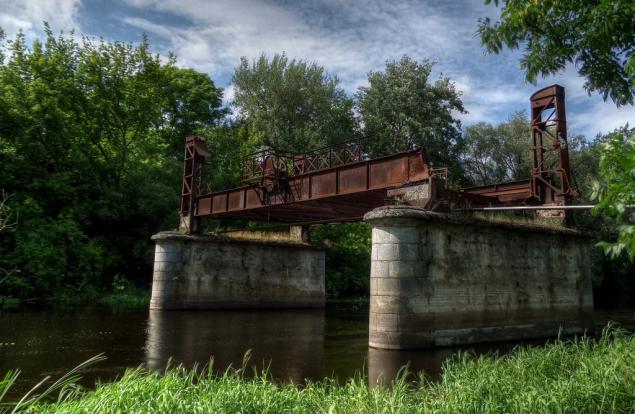
24, 25. The ruins of barracks 333 Infantry Regiment.

...

26. Terespolsky gate. View from inside.
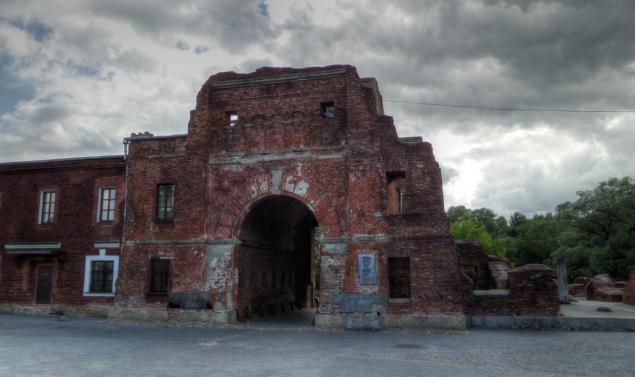
27. June 22, 2011 inaugurated the sculpture "To the Heroes of the border, women and children the courage of his immortality paced».
The idea of the project dedicated to the 70th anniversary of the feat of border guards, their wives and children, by the management of the State Border Committee of Belarus.
Platform for sculpture at the chosen place Terespolsky Gate, where, under the command of the chief of the 9th frontier Lieutenant A.M.Kizhevatova guards fought to the death.
Author sculpture sculptor-architect of Lenin Prize winner Valentin Pavlovich Zankovich - one of the members of the creative team to create a memorial complex "Brest Fortress».
The cost of the sculpture was more than 800 million rubles. Fundraising began after November 26, 2010 at a meeting of the coordinating council officer assemblies of the border service of Belarus was decided. Personnel and veterans of the border service, and various organizations in the country collected more than 450 million Belarusian rubles.
Participated in this project representatives of the border agencies of Russia, Kazakhstan and Ukraine. Thanks to them, more than 200 million rubles was spent on perpetuating feat. The sculpture is an image of three men going into battle, the commander's wife with children, the wounded guards who gives a woman a drink of water. In the center is placed a border post with the arms of the USSR and a plaque. The essence of the composition: the decisive battle for the Motherland - a symbol of national unity.
The monument is made of red, black granite and bronze.

28. The construction of the bypass channel started with the construction of the fortress. Its length is 6 km. Perfectly elaborate system of locks, cobble beaches, makes it not only a barrage of obstacles on the way forward possible opponent, but also a place for fish, boating and swimming. The water level is maintained constant.
Over the years, the channel is clogged, has failed gateway system. In August 1997, the Coordinating Council on the protection of tangible and intangible heritage at Brest Regional Executive Committee has decided to clean up the bypass channel. During cleaning of the channel in 1998-2001. found 187 items that have filled up the exposition and foundations of the memorial, removed and disposed of sappers 129 explosive objects.
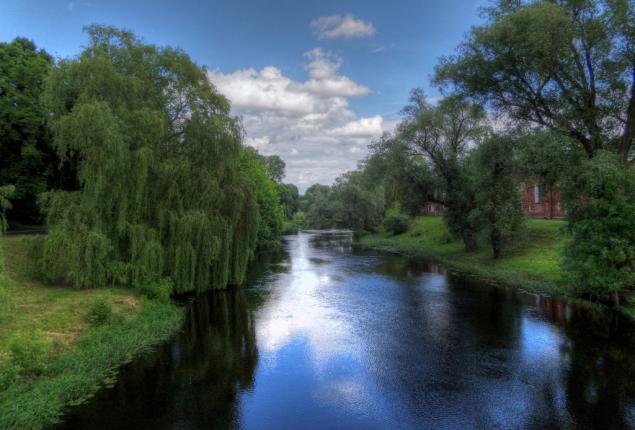
29. In 1851-1876 years in the fortress was built by the Orthodox church designed by the academician of the Russian Academy of Arts architect David Grimm. This domed building, a church in the Byzantine style basilica, inside which was established 8 columns. The light coming through the windows 7 in the altar area and the same number of windows on each side. Painted the church in the Romanesque style. Magnificent dome crowned George Cross.
In the early twentieth century St. Nicholas Cathedral was the main garrison church from western edge of one of the most beautiful built in the center of Europe. After the signing of the Treaty of Riga (March 18, 1921) temple, is now already in the territory that belonged to Poland in the years 1924-1929 was rebuilt in Roman Catholic garrison church for the project of Polish architect Julian Lisiecki.
Before the war it housed the club 84th Infantry Regiment. During the fighting in June-July 1941, the building became an important point of defense, as it is situated at the highest point of the island, a clear view of the entire territory of the fortress. On the morning of June 22, 1941 assault force fascists broke through Terespolsky gate in the citadel. The Nazis seized the club and dining komnachsostava. Divided into two groups, the enemy began to move towards the goal KHolmskim and Brest. In a counterattack, organized regimental commissar E.M.Fominym, and in other areas, the Germans were pushed back to the clubhouse and dining room, but managed to gain a foothold there. Most of the riot was destroyed by the end of the defenders of the first day of the war. Part of the detachment, took refuge in the club - by the end of the second day. The building is not just passed from hand to hand. It was one of the last pockets of resistance in the Citadel.
Many Red Army commanders, political workers were killed in the defense of Red Army club.
The building was severely damaged in the postwar years was preserved as a monument to the war. In the late 1960s, spent the outer building conservation and turned into a memorial complex.
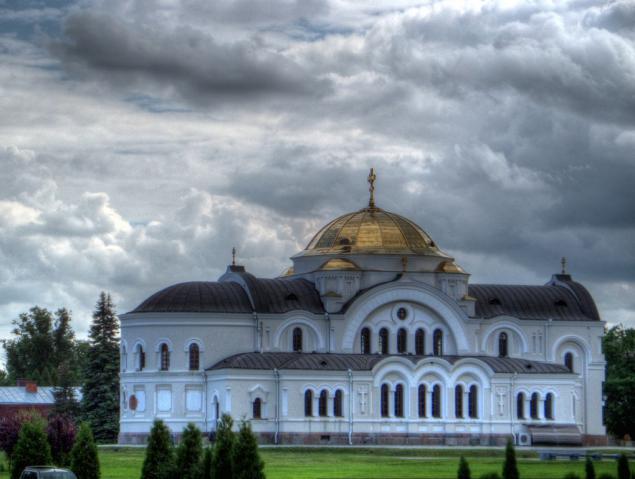
30. The main monument - a sculpture of a warrior and a banner.
This is a huge sculpture in size, consisting of 200 parts (with linear dimensions in terms of up to 54 m and a height of 30 m) was constructed in the form of a concrete shell, which is attached to a metal frame with mesh interior columns 6x6 m. The thin shell sculptures cast from concrete horizontal rows as the formwork from plaster molds with fastening it to the outside forests. In the shell of the main monument laid almost 4,000 m3 of concrete.
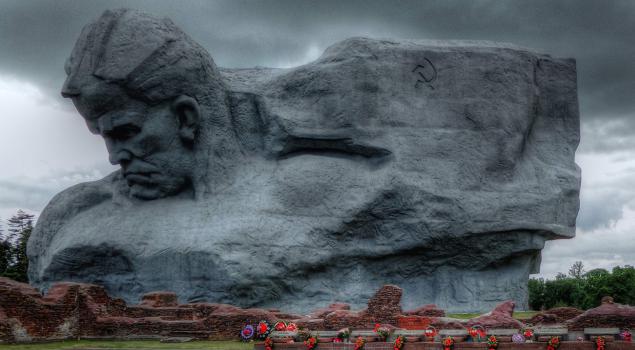
31. One of the main elements of the memorial is a hundred-meter obelisk-shaped quadrangular bayonet Russian Mosin rifle (trёhlineyki), symbolizing victory over the enemy, the eternal glory of the heroic defenders of the fortress. This is a complex engineering structure height 104, 5 m, weighing 620 tons.
In domestic practice of assembling such structures assembled in a horizontal position of the enlarged section made at the factory, was implemented for the first time.
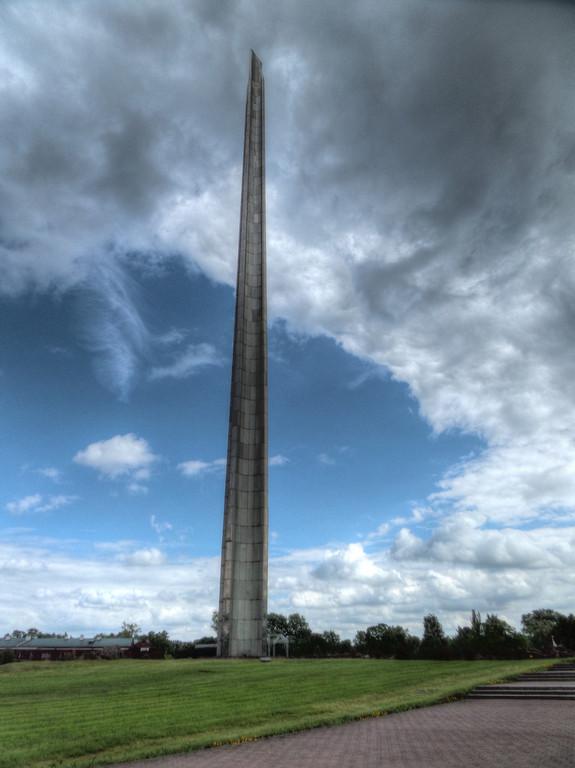
32. The bayonet is a sheet welded construction of tower type. The carrier element it has a cross-sectional shape of an octagon with the brand, adjacent to the means of its four sides. The size of the base - 5x5 m, to the top is reduced to 2, 6x0, 45 m. The bayonet is made of sheet steel 30x40 mm, which is attached decorative trim of titanium steel thickness 1 to 5 mm. Revetments bayonet took 14 tons of titanium steel.
All the bayonet was divided into 10 sections along the length of 10-13 m. Production was performed on sections Molodechno Plant of Metal Minmontazhstroya USSR. For transportation construction was equipped with a special train with the use of powerful tractors with trailers.
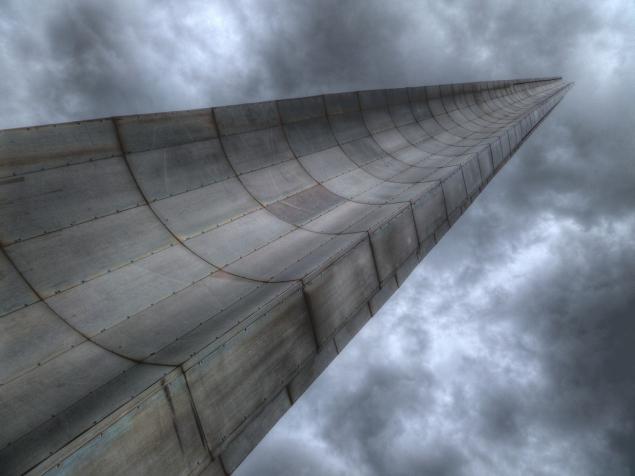
33. Next to the ruins of the Engineering Management - flame Eternal Flame. His torch as a small square plate with profound relief image in her five-pointed star is located in the center zaglublёnnoy playgrounds, paved with red granite. At the site - the inscription cast bronze letters: "fight to the death // Glory to the heroes."

34. Near the Eternal Flame - Memorial Playground Hero Cities of the Soviet Union, open May 9, 1985 By granite slabs depicting medal "Gold Star" set capsules with the ground hero cities, delivered here by their delegations.
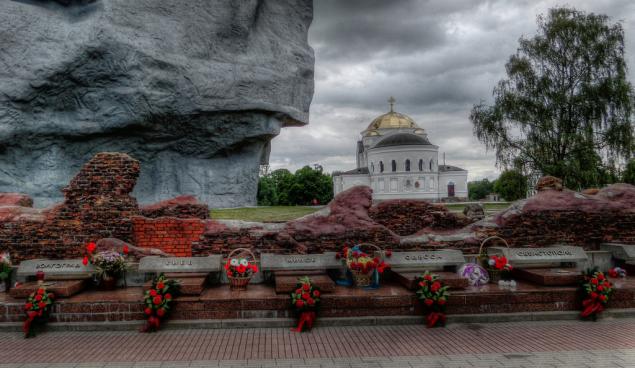
35. Trunk fortress held earthen wall height up to 10 m with stone casemates, for him - channels with bridges thrown over them, which led outside the fortress.
At the beginning of its existence, the Brest fortress was one of the most advanced Russian fortifications.
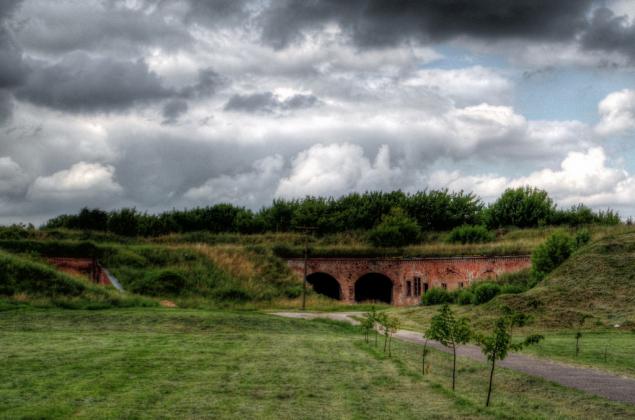
36, 37. In 1864, the reconstruction of the Brest Fortress. Built East and West redyuity - horseshoe strengthening with casemates, traverses, powder magazines in the 1878-1888 biennium. - 10 more forts, then the defensive line has reached 30 km. As a result of the 2nd Reconstruction (1911-1914.), Which was attended by military engineer D.M.Karbyshev fully upgraded line of fortifications.
At a distance of 6-7 km from the Brest fortress was created 2 line of forts.
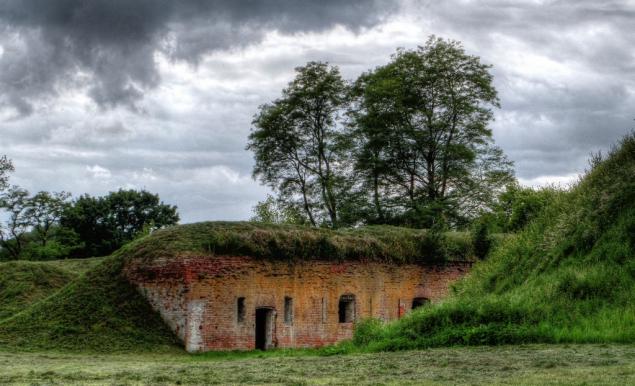
...
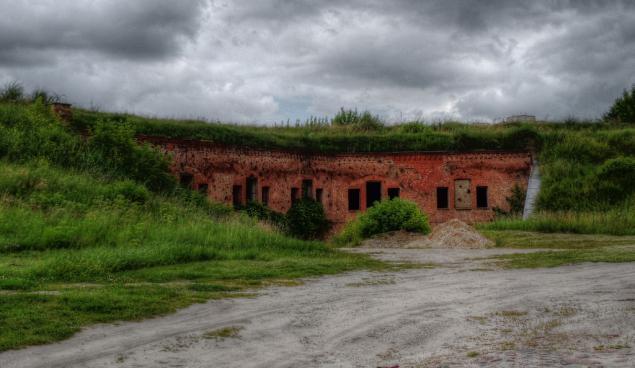
38. North Gate.
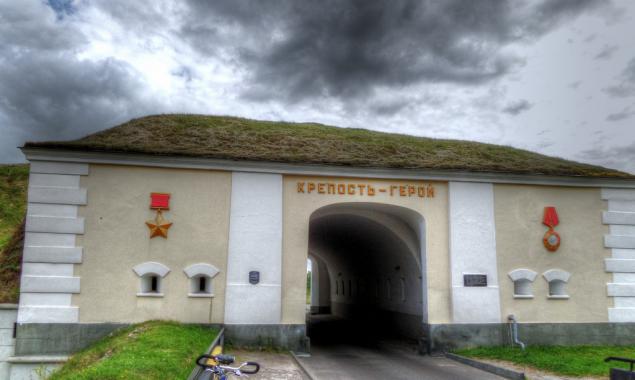
39. Map of the Brest Fortress.
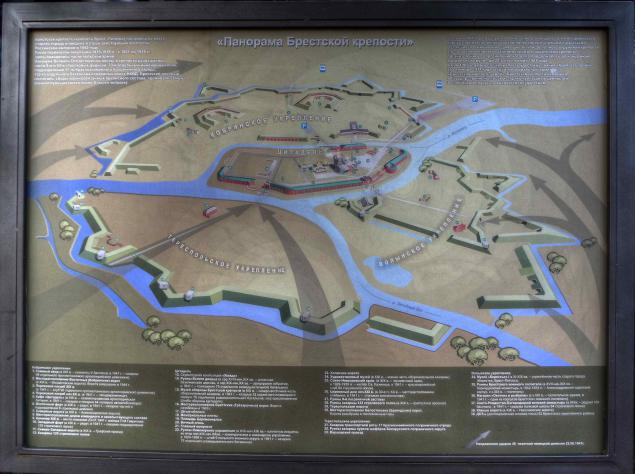
In addition, the survey was conducted by the method of "bracketing" (bracketing) pairs and triplets in different exposures, and then they were assembled into one image to the computer to increase the dynamic range - machinery HDR.

Historical information.
Brest fortress was built in the 30th - early 40-ies of the XIX century in the Western Bug river crossings and Mukhavets in place of the old Brest.
During construction, the entire town was moved to a new territory to the east of the citadel.
The fortress was located on 4 islands formed by bayous Mukhavets and Western Bug and channel system.
In the center of the fortress is the Citadel, or the central reinforcement, which is connected by bridges with 3 artificial island fortifications. This:
Kobrin strengthening (north-east side)
Terespol strengthening (west side)
Volyn fortification (south island)
Architecture Centre Citadel - Garrison Nicholas Church, built in the 1851-76 biennium.
The total area of the fortress is about 4 square kilometers.
From August 1915 until the end of World War Brest fortress was occupied by German troops.
In 1921, under the terms of the Treaty of Riga was ceded to Poland, which was composed before 1939.
In 1939, the Brest Fortress was transferred to the Soviet Union.
June 22, 1941 the garrison received the first blows Nazi invaders and more than a month kept the defense completely surrounded. After the war, for the courage and heroism of the defenders during its defense, the citadel has received the honorary title "Hero-Fortress».
The main entrance to the memorial complex is embedded in a concrete shaft parallelepiped with carved five-pointed star in it. Block supported slope rampart. Aisle width main entrance - 18, 5 m, length of reinforced concrete blocks - 44 m, height - 10 m, width - 35 m. The construction of 700 cubic meters of concrete were spent.

3. Concrete block rests on the earth mound and casemates, partially crashing and hanging over them. The internal design of the concrete block (40x35 m, height - 14 m) - made in prefabricated monolithic frame. External floors were made of reinforced concrete in the formwork clean, traces of which remain on the walls, giving them a peculiar form. Passage walls are lined with polished dark granite that contrasts with the speakers in the opening ruins casemates.

4. This creates a visual and emotional and psychological effect. Complement its radio call sign of the Central Soviet Union - the melody "Song of the Motherland" composer Dunayevsky, Yu.Levitana voice, which notifies the treacherous attack of Nazi Germany on the Soviet Union, the song composer A.Aleksandrova "holy war", the sounds of bombing and shooting. < br />

...

...

7. The Road to the Citadel.

8. On both sides of the entrance - casemates eastern part of the main shaft of the fortress. On the brick wall of one of them on the board of silver iron - cast in bronze text of the decree of the Presidium of the Supreme Soviet of the USSR in Russian and Belarusian languages on assignment Brest Fortress title "Hero-Fortress". The star doorway entrance reveals a view of the central part of the fortress.

...

10, 11. The view of the Citadel.

...

12. At the Citadel, on the left bank of the bayou is Mukhavets sculpture "Thirst».
One of the dramatic pages of Brest Fortress - an acute shortage of water. Water supply has been disabled on the first day of the war, and the summer that year stood unusually hot. Smoke, burning gunpowder filled the horizon.
Blackened faces of fighters, parched with thirst lips showed incredible suffering people. The water was needed to cool the machine guns, the wounded, women and children - all participants of Defense. It seemed to the river and take it, but the approaches to water shelled, floodlit at night shore. Many soldiers and officers were killed, trying to extract the precious drops. After the war, on the banks of the rivers found punched helmets, water bottles, mugs, and the remains of the victims. The creators of the memorial, knowing about this tragedy, decided to talk about it, using the skill of the sculptor. The figure of a soldier crawling to the water with his helmet in his hand, does not leave anyone indifferent.
Today outstretched helmet - fresh flowers from visitors to the fortress.

13-16. Ruins near Kholmsky gate.

...

...

...

17. Kholm Gate. Previously had 4 towers with battlements. Over the entrance aperture Terespolsky was 4 tiers of windows, battlements over which later built on a 3-tiered tower with a lookout platform.

18. "Here, in June 1941, fought heroically against the Nazi invaders separate battalion of 132 soldiers of the NKVD. Eternal glory to the heroes. »

19. The river empties into Mukhavets r.Zapadny Bug. The border with Poland.

20. View Terespolsky gate.

21. Terespolsky gate.

22. Location Bialystok (Brigitskih) wide. Dismantled after the war.

23. Could not figure out what it is - the remains of a bridge or part of a system of locks. Or complex engineering system.
Strictly speaking, this is the border zone and we need a passport with a pass.

24, 25. The ruins of barracks 333 Infantry Regiment.

...

26. Terespolsky gate. View from inside.

27. June 22, 2011 inaugurated the sculpture "To the Heroes of the border, women and children the courage of his immortality paced».
The idea of the project dedicated to the 70th anniversary of the feat of border guards, their wives and children, by the management of the State Border Committee of Belarus.
Platform for sculpture at the chosen place Terespolsky Gate, where, under the command of the chief of the 9th frontier Lieutenant A.M.Kizhevatova guards fought to the death.
Author sculpture sculptor-architect of Lenin Prize winner Valentin Pavlovich Zankovich - one of the members of the creative team to create a memorial complex "Brest Fortress».
The cost of the sculpture was more than 800 million rubles. Fundraising began after November 26, 2010 at a meeting of the coordinating council officer assemblies of the border service of Belarus was decided. Personnel and veterans of the border service, and various organizations in the country collected more than 450 million Belarusian rubles.
Participated in this project representatives of the border agencies of Russia, Kazakhstan and Ukraine. Thanks to them, more than 200 million rubles was spent on perpetuating feat. The sculpture is an image of three men going into battle, the commander's wife with children, the wounded guards who gives a woman a drink of water. In the center is placed a border post with the arms of the USSR and a plaque. The essence of the composition: the decisive battle for the Motherland - a symbol of national unity.
The monument is made of red, black granite and bronze.

28. The construction of the bypass channel started with the construction of the fortress. Its length is 6 km. Perfectly elaborate system of locks, cobble beaches, makes it not only a barrage of obstacles on the way forward possible opponent, but also a place for fish, boating and swimming. The water level is maintained constant.
Over the years, the channel is clogged, has failed gateway system. In August 1997, the Coordinating Council on the protection of tangible and intangible heritage at Brest Regional Executive Committee has decided to clean up the bypass channel. During cleaning of the channel in 1998-2001. found 187 items that have filled up the exposition and foundations of the memorial, removed and disposed of sappers 129 explosive objects.

29. In 1851-1876 years in the fortress was built by the Orthodox church designed by the academician of the Russian Academy of Arts architect David Grimm. This domed building, a church in the Byzantine style basilica, inside which was established 8 columns. The light coming through the windows 7 in the altar area and the same number of windows on each side. Painted the church in the Romanesque style. Magnificent dome crowned George Cross.
In the early twentieth century St. Nicholas Cathedral was the main garrison church from western edge of one of the most beautiful built in the center of Europe. After the signing of the Treaty of Riga (March 18, 1921) temple, is now already in the territory that belonged to Poland in the years 1924-1929 was rebuilt in Roman Catholic garrison church for the project of Polish architect Julian Lisiecki.
Before the war it housed the club 84th Infantry Regiment. During the fighting in June-July 1941, the building became an important point of defense, as it is situated at the highest point of the island, a clear view of the entire territory of the fortress. On the morning of June 22, 1941 assault force fascists broke through Terespolsky gate in the citadel. The Nazis seized the club and dining komnachsostava. Divided into two groups, the enemy began to move towards the goal KHolmskim and Brest. In a counterattack, organized regimental commissar E.M.Fominym, and in other areas, the Germans were pushed back to the clubhouse and dining room, but managed to gain a foothold there. Most of the riot was destroyed by the end of the defenders of the first day of the war. Part of the detachment, took refuge in the club - by the end of the second day. The building is not just passed from hand to hand. It was one of the last pockets of resistance in the Citadel.
Many Red Army commanders, political workers were killed in the defense of Red Army club.
The building was severely damaged in the postwar years was preserved as a monument to the war. In the late 1960s, spent the outer building conservation and turned into a memorial complex.

30. The main monument - a sculpture of a warrior and a banner.
This is a huge sculpture in size, consisting of 200 parts (with linear dimensions in terms of up to 54 m and a height of 30 m) was constructed in the form of a concrete shell, which is attached to a metal frame with mesh interior columns 6x6 m. The thin shell sculptures cast from concrete horizontal rows as the formwork from plaster molds with fastening it to the outside forests. In the shell of the main monument laid almost 4,000 m3 of concrete.

31. One of the main elements of the memorial is a hundred-meter obelisk-shaped quadrangular bayonet Russian Mosin rifle (trёhlineyki), symbolizing victory over the enemy, the eternal glory of the heroic defenders of the fortress. This is a complex engineering structure height 104, 5 m, weighing 620 tons.
In domestic practice of assembling such structures assembled in a horizontal position of the enlarged section made at the factory, was implemented for the first time.

32. The bayonet is a sheet welded construction of tower type. The carrier element it has a cross-sectional shape of an octagon with the brand, adjacent to the means of its four sides. The size of the base - 5x5 m, to the top is reduced to 2, 6x0, 45 m. The bayonet is made of sheet steel 30x40 mm, which is attached decorative trim of titanium steel thickness 1 to 5 mm. Revetments bayonet took 14 tons of titanium steel.
All the bayonet was divided into 10 sections along the length of 10-13 m. Production was performed on sections Molodechno Plant of Metal Minmontazhstroya USSR. For transportation construction was equipped with a special train with the use of powerful tractors with trailers.

33. Next to the ruins of the Engineering Management - flame Eternal Flame. His torch as a small square plate with profound relief image in her five-pointed star is located in the center zaglublёnnoy playgrounds, paved with red granite. At the site - the inscription cast bronze letters: "fight to the death // Glory to the heroes."

34. Near the Eternal Flame - Memorial Playground Hero Cities of the Soviet Union, open May 9, 1985 By granite slabs depicting medal "Gold Star" set capsules with the ground hero cities, delivered here by their delegations.

35. Trunk fortress held earthen wall height up to 10 m with stone casemates, for him - channels with bridges thrown over them, which led outside the fortress.
At the beginning of its existence, the Brest fortress was one of the most advanced Russian fortifications.

36, 37. In 1864, the reconstruction of the Brest Fortress. Built East and West redyuity - horseshoe strengthening with casemates, traverses, powder magazines in the 1878-1888 biennium. - 10 more forts, then the defensive line has reached 30 km. As a result of the 2nd Reconstruction (1911-1914.), Which was attended by military engineer D.M.Karbyshev fully upgraded line of fortifications.
At a distance of 6-7 km from the Brest fortress was created 2 line of forts.

...

38. North Gate.

39. Map of the Brest Fortress.


